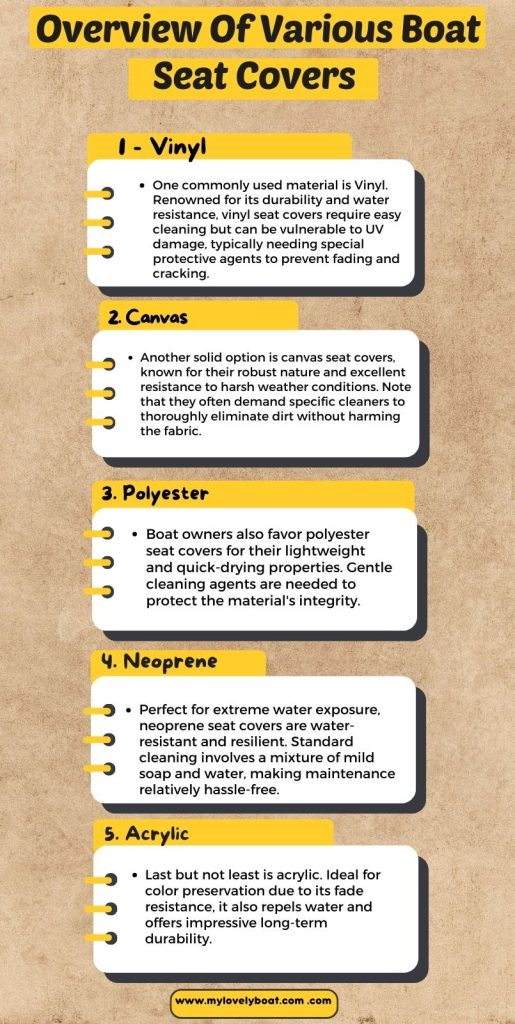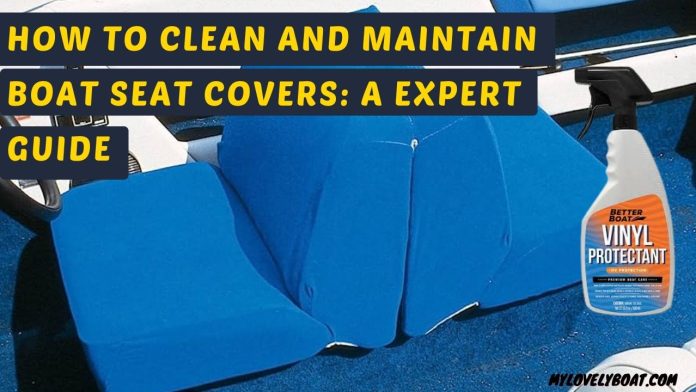Why You Can Trust: We are dedicated to providing our readers with the most comprehensive, expert advice on a wide range of products. If you buy through our links, we may get a commission.
- The Importance of Maintaining and Cleaning Boat Seat Covers
- Overview of Various Boat Seat Covers and Materials
- Understanding how each material reacts to different cleaning methods will assist in better maintenance, ensuring you achieve the longevity and aesthetic appeal desired for your seat covers.
- Tools and Products Required for Cleaning and Maintenance
- Detailed step-by-step Guide on Cleaning Boat Seat Covers
- Guide on Maintaining Boat Seat Covers
- How to Deal with Specific Challenges
- Tips for Increasing Longevity of Boat Seat Covers
- FAQ-
Boat seat covers are crucial components that contribute to your boat’s overall look, comfort, and longevity. They’re often exposed to harsh elements, making cleaning and maintaining them correctly essential to boat care.
This blog post offers comprehensive guidance on cleaning and maintaining your boat seat covers effectively, ensuring they remain in prime condition for many years.
The Importance of Maintaining and Cleaning Boat Seat Covers
- Aesthetics: Proper cleaning and maintenance keep seat covers looking great, enhancing the overall visual appeal of your boat.
- Prevent Damage: Timely upkeep helps avoid wear and tear, preventing the seat cover material from degrading and extending its lifespan.
- Health: Regular cleaning prevents mould and mildew buildup, ensuring a healthy on-board environment for you and your guests.
- Comfort: Well-maintained seat covers provide optimal comfort during your boating trips.
- Value: Preserved functionality and appearance of seat covers contribute to maintaining your boat’s overall value.
- Early Detection: Routine maintenance identifies damages early, allowing for prompt repairs or replacements.
Overview of Various Boat Seat Covers and Materials

Regarding boat seat covers, numerous options are available on the market, each made from a different type of material with unique features and care requirements.
One of the most common materials used is Vinyl, prized for its durability and resistance to water. Vinyl seat covers are easy to clean but susceptible to UV damage. They may need special protectants to prevent cracking and fading.
Canvas seat covers are another popular choice, known for their robustness and ability to withstand adverse weather conditions. They are often more challenging to clean than Vinyl, needing specific types of cleaners to eliminate dirt without damaging the fabric.
Polyester seat covers, characterized by their lightweight and quick-drying nature, are also favoured by boat owners. These require gentle cleaning agents to avoid compromising the material’s integrity.
Lastly, neoprene seat covers make an excellent choice for extreme water exposure, being water-resistant and durable. As for cleaning, mild soap and water will typically do the trick.
Understanding how each material reacts to different cleaning methods will assist in better maintenance, ensuring you achieve the longevity and aesthetic appeal desired for your seat covers.
Tools and Products Required for Cleaning and Maintenance
Proper care and maintenance of boat seat cover require an array of specialized tools and cleaning products that suit various materials. Here are some necessary tools and products, as well as their specific uses:
- Soft-Bristle Brush or Detailing Brush: This tool is essential for gently scrubbing and removing surface dirt and stains from seat covers. The soft bristles ensure the fabric is not damaged during the cleaning process.
- Mild Soap or Boat Seat Cleaner: A gentle soap or boat seat cleaner is vital for cleaning seat covers without causing fading or discolouration. Make sure to choose a cleaner designed for your specific seat cover material.
- Microfiber Towels: These highly absorbent towels are perfect for wiping down surfaces after cleaning and rinsing, ensuring no residue and facilitating drying.
- UV Protectant Spray: Applying a UV protectant spray to seat covers, especially Vinyl ones, can prevent sun damage and fade by blocking harmful ultraviolet rays.
- Mildew Remover: Specially formulated mildew removers can help you tackle mildew and mould issues on seat covers, ensuring they remain fresh and free of harmful growths.
- Waterproofing Spray: For materials like canvas, polyester, and neoprene, applying a waterproofing spray after cleaning can enhance the seat cover’s ability to withstand water exposure, prolonging its lifespan.
- Stiff Brush: A more rigid brush may provide a more rigorous cleaning for more stubborn stains or areas with tough dirt. However, this should be done cautiously to avoid damage to the seat cover fabric.
These essential tools and products ensure a thorough and efficient cleaning process for all boat seat covers, maintaining their appearance and longevity.
Detailed step-by-step Guide on Cleaning Boat Seat Covers

Regardless of material type, boat seat covers require regular and adequate care to maintain their appearance and longevity. Here is a step-by-step guide to cleaning your seat covers effectively:
Step 1: Remove the Seat Covers
Remove the seat covers from the seats. Detaching them makes it easier to access all areas thoroughly while avoiding any moisture damage to the underlying boat seat cushions. This helps maintain the seat’s durability and enhances overall cleanliness, ensuring pleasant and comfortable experiences on your boating adventures.
Step 2: Dry Brushing
Using a soft-bristle brush, gently dry brush the seat covers to remove any loose dirt, sand, or debris. This process will help prevent scratches or scuffs during the subsequent cleaning steps. Be thorough, pay attention to seams and edges, where dirt can accumulate, thereby maximizing your cleaning effectiveness.
Step 3: Prepare the Cleaning Solution
Choose an appropriate soap or boat seat cleaner based on the seat cover material. Mix the cleaning solution with water per the label instructions, ensuring the correct concentration for effective cleaning. Ensure to agitate the solution until it is evenly mixed. Always put on protective gloves before handling the solution to safeguard your skin.
Step 4: Apply the Cleaning Solution
Dip a soft-bristle brush or detailing brush into the cleaning solution and gently scrub the seat covers. Work in sections, paying close attention to the seams and crevices where dirt can accumulate.
For stubborn stains or dirt, a stiffer brush can be used cautiously to avoid damaging the fabric. It’s also essential to clean both sides of the seat cover to ensure thoroughness. Avoid harsh chemicals or abrasive cleaners for vinyl seat covers, as they can harm the material’s surface.
Step 5: Rinse
Once scrubbing is completed, rinse the seat covers thoroughly with clean water. Using a garden hose with a spray nozzle or a pressure washer set at low pressure can help remove any remaining dirt or soap residue.
Step 6: Dry the Seat Covers
Once the seat covers have been rinsed, gently remove any excess water with a micro fiber towel. Allow the seat covers to air dry in a well-ventilated, shaded area. Direct sunlight can damage or fade some materials, so keeping the seat covers dry is necessary before re-installing them to avoid mould or mildew growth.
Step 7: Apply Protectants and Waterproofing
Once the seat covers are clean and dry, consider applying a UV protectant spray for vinyl seat covers or a waterproofing spray for materials like canvas, polyester, and neoprene. These treatments can prolong the lifespan of your seat covers and ensure they remain in prime condition.
Tips for Best Results
- Opt for cleaning boat seat covers on an excellent, overcast day to prevent any streaking or residue caused by quick evaporation.
- Establish a regular cleaning routine based on your usage patterns and the seat cover material to keep the covers looking their best.
- Inspect your seat covers for any damage during the cleaning process and address any issues promptly.
By following this comprehensive cleaning guide and incorporating helpful tips, you can ensure your boat seat covers remain in exceptional condition for years.
Guide on Maintaining Boat Seat Covers

Apart from cleaning, proper maintenance of boat seat covers is crucial for their durability and aesthetic appeal. Here are some methods and factors to consider when maintaining boat seat covers:
Ideal Cleaning Frequency
The best time to clean your boat seat covers varies depending on a variety of factors, including how often you use them, the material of the seat cover, and how exposed they are to the elements.
Generally, boat seat covers should be cleaned at least once per month during active use or whenever they begin to look dirty.
A thorough cleaning and inspection should also be performed at the end of each boating season or before extended storage.
By keeping your boat seat covers clean regularly, you can prevent the accumulation of dirt or damage that can cause more serious problems.
Post-Use Maintenance Habits
Establishing simple post-use maintenance habits can significantly impact prolonging your boat seat covers’ lifespan. After each boating trip, make sure to:
- Remove trash, food debris, or personal belongings from your boat seats.
- Wipe off moisture or spills from the seat covers to prevent moulding or staining.
- Allow proper ventilation to ensure seat covers and boat cushions air-dry completely before storage.
Proper Storage and Use of Boat Cover
Investing in a quality boat cover can tremendously benefit the maintenance of your boat seat covers. Boat covers help protect the seat covers and other boat interior components from sun exposure, environmental contaminants, and harsh weather conditions. To make the most of your boat cover:
- Ensure the boat cover is clean and in good condition, free from any rips or tears that may expose your boat seat covers to the elements.
- Choose a boat cover material that offers excellent UV protection and is weather-resistant, ensuring comprehensive safety for your boat and seat covers.
- Store your boat in a shaded or covered area whenever possible, limiting your seat covers’ exposure to sunlight and other harmful elements.
Periodic Inspection and Repair
A crucial aspect of maintaining boat seat covers is performing periodic inspections to identify any damage, such as tears, punctures, fraying, or excessive wear.
Address any issues promptly by either repairing the damage or replacing the seat cover if necessary.
Additionally, ensure that hardware or attachments are in good working order to avoid mishaps or ineffective use.
Educate Guests
Inform your guests about proper boat etiquette, such as avoiding sharp objects, wearing abrasive clothing on boat seats, and refraining from standing or jumping on seat cushions. Education and awareness can minimize unnecessary wear and tear on your boat seat covers.
How to Deal with Specific Challenges
Boat seat covers can often encounter unique challenges like mould and mildew growth due to their constant exposure to a moist environment.
Removing Mold or Mildew
Mould and mildew often appear as discoloured patches and spots. They don’t just hurt the appearance of your boat seat covers but can also deteriorate the material if left untreated.
For removing mould or mildew:
- Use a specialized mildew remover designed for the seat cover material.
- Apply the remover as per the product’s instructions.
- After treatment, rinse the cover thoroughly with clean water and let it dry in a well-ventilated area.
If a mildew remover is unavailable, a mild dish soap or vinegar and water solution is another option.
Tips for Quick Action and Prevention
In addition to these, here are a few tips for quick action and prevention:
- As soon as you detect signs of mould or mildew, take immediate action. The sooner you remove them, the less damage they will cause.
- Aim for thorough air-drying after each use of the boat, reducing the chance of mould growth.
- Store your boat seat covers in a well-ventilated area to help prevent moisture buildup.
- Clean and dry any spills immediately to prevent potential mould or mildew growth.
- Using a dehumidifier in your storage area can help decrease moisture levels.
Understanding how to deal with challenges specific to boat seat covers like mould and mildew and taking preventative measures can keep your seat covers looking fresh and in excellent condition for a long time.
Tips for Increasing Longevity of Boat Seat Covers
The lifespan of boat seat covers can be noticeably extended through regular care and these preventative measures:
- Prompt Cleaning: Avoid leaving stains or dirt on the seat covers for extended periods. Clean them promptly to prevent long-term damage.
- Avoid Direct Sunlight: Minimize direct sunlight exposure as much as possible. Over time, UV radiation can cause fading or weakening of seat cover materials.
- Use Protective Sprays: Regularly apply UV protectant sprays or waterproofing treatments for additional protection.
- Proper Storage: Store your boat and seat covers in a dry, well-ventilated area, ideally under a quality boat cover.
- Regular Inspections: Perform routine checks for any damage, addressing issues immediately.
By implementing these habits, you can significantly increase the longevity of your boat seat covers, maintaining their appearance and performance for years to come.
More Resources:
- The 20 Most Useful Boat Seat Accessories Every Boater Should Consider
- How Do I Protect My New Boat Seats? 7 Secret Tips
- The Ultimate Guide to Boat Seat Covers: Types, Materials, Benefits, and Maintenance
- 7 Simple Tips to Protect Your Boat Seats from Bird Droppings
- Top 23 Must-Have Boat Accessories for Every Boater Need.
- 16 Essential Comfort and Relaxation Boat Accessories
- Top 100+ Romantic Boat Names That Will Make You Fall In Love
FAQ-
What is the ideal frequency for cleaning boat seat covers?
Cleaning boat seat covers once a month or whenever they appear visibly dirty is typically recommended. However, cleaning frequency may also depend on how often you use your boat and the environmental conditions it is exposed to.
Why is thorough rinsing necessary while cleaning boat seat covers?
Thorough rinsing is essential to remove all the soap residue and loosened dirt. The remaining soap can attract more dirt and cause discolouration if not wholly rinsed.
What sprays can be used on boat seat covers after cleaning?
Depending on the material of the seat cover, UV protectant sprays for Vinyl or waterproofing sprays for other fabrics can be applied post-cleaning to prolong their lifespan.
Can I dry my boat seat covers in the sun?
It is advisable to keep boat seat covers out of direct sunlight for drying. UV exposure can lead to material damage or fading over time.
Can harsh chemicals be used for persistent stains on boat seat covers?
It’s generally recommended to avoid harsh chemicals on boat seat covers as they can damage the material. If a stain is persistent, using a stiffness brush and appropriate cleaners can be beneficial.
What causes boat seat covers to fade?
Prolonged exposure to sunlight, harsh weather conditions, and improper cleaning methods can cause seat covers to fade over time.
Can boat seat covers be reupholstered?
Boat seat covers can be reupholstered if the material is excessively worn out, faded, or damaged. It’s important to employ professional services for the best results.

I am a freelance writer passionate about watersports and the great outdoors. I have many years of experience in the marine industry, and I enjoy sharing my knowledge and expertise with others so that they can get the most out of their boating experiences. I like fishing, kayaking, and exploring new destinations by boat whenever I have time. Contact Us: Linkedin







